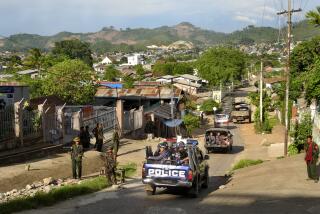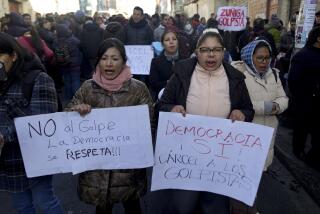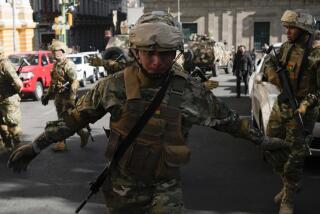Rebels Battle Troops in Manila and Army Headquarters
- Share via
MANILA — Rebel soldiers battled loyalist troops in the financial district and at armed forces headquarters today, the third day of the attempt to overthrow Philippine President Corazon Aquino. One group of 150 rebels reportedly surrendered at the army camp.
The fighting belied government claims that the latest coup attempt against Aquino had failed. Officials say at least 42 people have been killed and 200 wounded since the rebels launched their attacks early Friday.
Aquino, facing the sixth attempted coup since coming to power nearly four years ago, said today she had rejected a cease-fire proposal from the rebel coup leaders. “What they have started, we will finish,” she declared in a national radio address.
Earlier, she had told the mutineers to “surrender or die.”
Rebels bombarded the military headquarters at Camp Aguinaldo early today with 105-millimeter howitzers, and government jet fighters and helicopter gunships attacked the mutineers’ positions.
Witnesses said two jet fighters flew at least seven passes, rocketing rebel strongholds near the camp.
The military said the rebels also launched a ground attack on Camp Aguinaldo, in suburban Quezon City five miles east of Aquino’s office, but it was repulsed after a four-hour battle. The Philippine News Agency reported that 150 mutineers who had occupied the camp’s chapel surrendered after loyalist forces surrounded the building.
Hundreds of military families fled the sprawling compound during the fighting, and hospitals reported three people were killed and 25 wounded by the rebel bombardment.
In Manila’s Makati financial district, where many foreign embassies and businesses are located, heavy firing broke out at mid-morning as government troops tried to move against rebels holding the Intercontinental Hotel.
Rebels fired volleys of machine-gun fire from Makati skyscrapers, and snipers shot at vehicles on Epifanio de los Santos Avenue. Garbage piled up in streets because both sides in the fighting were commandeering collection trucks for street barricades.
A spokesman for the U.S.-run Clark Air Base said there were no American warplanes in the skies over Manila today. U.S. military planes began flying cover for government troops Friday, hours after rebels launched their assaults, but American officials said the U.S. planes ended those flights at 6 a.m. Saturday.
But U.S. military advisers are increasingly helping the government forces coordinate attacks, communications and logistics behind the scenes, according to a reliable source.
“The Americans are reluctantly, slowly but steadily, having to add just a little bit every few hours,” the source said this morning.
The advisers initially helped with command and control as the Philippine armed forces struggled to contain the rebel attacks. Then they began assisting with communications between military units. The government has been repeatedly unable to reinforce besieged positions, or make advances
“Next step is they start moving them around the country, using helicopters and aircraft,” the source said.
In the Makati district, mutineers continued to occupy other buildings as well as the Intercontinental Hotel. Rebel snipers were stationed atop the Intercontinental, and groups of heavily armed rebel marines and Scout Rangers, the elite anti-guerrilla group, held positions on Ayalla Avenue, where Christmas angels and other decorations twinkled through the night.
Rebels also were reported holding two multistory parking lots, a shopping center and a supermarket. Government armored personnel carriers battled with rebel positions in a nearby park.
Rebels blocked off a major street with commandeered trucks. One mutineer said his group changed the color of its shoulder patches from white to red “because red is the color of blood, and we want to shed blood for our cause.”
“Things are not over,” a Western military official said. “It’s very much an ongoing thing. The rebel determination is quite strong.”
The official said a “conservative estimate” of rebel strength was 1,500 to 2,000. He said the rebels were claiming to have more than 3,000 men. He praised the rebels for “masterly military planning” and said the government response has appeared “inexperienced and kind of panicky.”
“When they do fight back, whenever they bring in helicopters or F-5s, they wind up killing civilians,” he said.
As fighting intensified, Cardinal Jaime Sin, the Roman Catholic archbishop of Manila, appealed for the rebels to stop their attacks.
“Your crusade has resulted in the loss of so many innocent lives,” he said in a radio address. “I am pleading with you to return to your senses and surrender.”
A government spokesman said Aquino and her family attended Mass at the Malacanang Palace.
The country’s two international airports in Manila and Cebu remained closed today, and domestic flights were also canceled.
Military Chief of Staff Gen. Renato de Villa said Saturday that rebels controlled parts of Manila and the Mactan Air Base in Cebu, 350 miles south of Manila.
Military officials said one coup leader--an associate of renegade Lt. Col. Gregorio (Gringo) Honasan, who led a 1987 coup try--has been arrested. Honasan is reported to be one of the leaders of the current coup attempt.
Police said some assailants may have been Communist insurgents seeking to take advantage of confusion brought on by the coup attempt, which began Friday when mutineers seized air force headquarters at Villamor Air Base in Manila, the government television station, and other strongpoints. The rebels later gave up the air base and station.
Aquino’s failure to crush the 20-year-old Communist insurgency is one reason for the discontent with her government, particularly within the military. She also has been criticized for not improving the Philippines’ economy since coming to power in a 1986 military-civilian uprising that ousted President Ferdinand E. Marcos.
The army commander, Maj. Gen. Manuel Cacanando, said he was nearly captured in the early hours of the assault. Cacanando said the mutineers included some of his most elite units.
Cacanando said the mutineers took hostage the entire operations staff of the army and nearly captured him when they seized parts of Ft. Bonifacio.
“A few seconds more and they would have gotten me,” Cacanando said in a radio interview Saturday. Cacanando said he hid for nearly 24 hours.
Aquino, in her address today, accused the rebbels of using civilians as shields.
“This is a tragic distortion of people power,” she said. “In February, 1986, those very civilians came out of their own free wills to save the lives of these rebels in that very spot.
“Now the rebels are holding them at gunpoint to do the same. This is a new low for the rebels.”
It shows the fate they had in store for our people. It shows their total disregard for human life.”
Aquino said the chief justice of the Supreme Court had “firmly rejected the rebel offer that he serve as interim president,” and called for “unity in support of the constitution and the government.”
She said that to the rebel proposal for a cease-fire, “our counterattacking forces have conveyed my answer. I reject their proposal. I said they would live only to regret their evil acts, and so they shall. There wil be no cease-fire. What they started I will end.”
More to Read
Sign up for Essential California
The most important California stories and recommendations in your inbox every morning.
You may occasionally receive promotional content from the Los Angeles Times.













